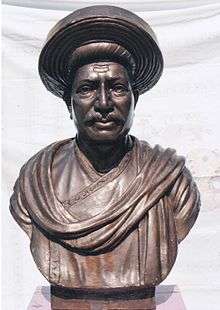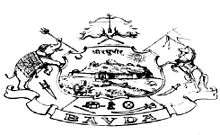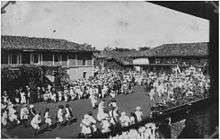Ramchandra Pant Amatya

| Ramchandra Pant Amatya Bavdekar | |
|---|---|
| Amatya Hukumat Panah of the Maratha Empire | |
| Born |
1650 Kolwan (Pune District, Maharashtra) |
| Died |
1716 Panhala (Kolhapur District, Maharashtra) |
| Spouse | Janakibai |
| Religion | Hindu |
Ramchandra Neelkanth Bawadekar (1650–1716), also known as Ramchandra Pant Amatya, served on the Council of 8 (Ashta Pradhan) as the Finance Minister (Amatya) to Emperor (Chhatrapati) Shivaji dating from 1674 to 1680.[1] He then served as the Imperial Regent (Hukumat Panah) to four later emperors, namely Sambhaji, Rajaram, Shivaji II and Sambhaji II. He authored the Adnyapatra, a famous code of civil and military administration, and is renowned as one of the greatest civil administrators, diplomats and military strategists of the Maratha Empire.
Early life
Ramchandra Pant was born in a Deshastha Brahmin ( देशस्थ ब्राह्मण ) family in approximately 1650. He was the youngest son of Neelkanth Sondeo Bahutkar (more popularly known as Nilo Sondeo) who had risen from a local revenue collection post (Kulkarni) to the post of Minister in the court of Shivaji Maharaj,
His family came from the village of Kolwan, near Kalyan Bhiwandi. Ramchandra Pant's grandfather Sonopant and uncle Abaji Sondeo were in the close circle of Shivaji. The Bahutkar family was closely associated with Samarth Ramdas, the spiritual guru of Shivaji Maharaj Samarth Ramdas is believed to be the one who named the newly born child as Ramchandra.
Early career
Before 1672, Ramchandra Pant was engaged in various clerical jobs in Shivaji's administration. In 1672, he and his elder brother Narayan were both promoted to the post of Revenue Minister (Mujumdar) by Shivaji. In 1674, at the coronation ceremony, the post of Mujumdar was renamed as Amatya and the title was solely bestowed upon Ramchandra Pant. He worked in this capacity until 1678. On his death bed, Shivaji named him as one among six pillars of the Maratha Empire that would save the kingdom in difficult times.
After Shivaji's death in 1680, Sambhaji became ruler of the Maratha Empire and Ramchandra Pant continued with his administration in various posts. Among other duties, Ramchandra Pant was sent to Prince Akbar, Aurangzeb's rebel son, for negotiations and, in 1685, Sambhaji also deployed him as an envoy to Vijapur for certain sensitive talks.
Amatya of 5 Chhatrapaties
Ramchandra Pant Amatya was the only person (Amatya) who dedicatedly served The Maratha Swarajya under 5 Chhatrapati’s in a row. When the Marathi empire was in trouble he used his wisdom, dedication to the throne and even force as needed to keep the empire and its Swarajya safe.
During the coronation of Shivaji Maharaj, Ramchandra Pant Amatya was the youngest Pradhan of all the Asthapradhan’s existing at that time. Thereafter, during the reign of Sambhaji Maharaj, Rajaram Maharaj, Maharani Tarabai and (Kolhapur’s fist ruler) Sambhaji Raje, Pant Amatya always held a prominent positions . As Riyasatkar(s) rightly said that ‘ever since the time of Shivaji Maharaj , Ramchandra Pant Amatya was the only person in the history of the Marathas who seems to have dedicatedly served the throne.’ Ramchandra Pant Amatya has laid down all the experiences encountered by him, while serving the throne in his book Rajniti (Adnyapatra) . The said book is a testament to his dedication and service to the throne of Chatrapati’s and Hindavi Swarajya.
The forefathers of Ramchandra Pant Amatya had close relations with the Bhosle Gharana even before the establishment of Swarajya. Before the coronation of Shivaji Maharaj, Ramchandra Pant Amatya’s father used to participate in various initiatives undertaken by Shivaji Maharaj. Ramchandra Pant Amatya subsequently carried forward this (his father’s) tradition with even more impact. Ramchandra Pant Amatya took the lead when it came to the protection of the Swarajya. Being Impressed by his efforts, Shivaji Maharaj included Ramchandra Pant as Amatya in his First AshtaPradhan mandal i.e. Council of Ministers. This, in itself portrays the qualities that Ramchandra Pant Amatya possessed. During the coronation ceremony of Shivaji Maharaj, Pant was included as Amatya. He must’ve been 22–23 years old then. Before the coronation, a PradhanMandal was appointed by Maharaj in the year 1662 which included Ramchandra Pant’s father Neelkanth Sondev as Maharaj’s Amatya. This legacy was carried forward, as after the death of Neelkanth Sondev his son Ramchandra Pant was appointed as Maharaj’s Amatya.
According to the information provided by the bakharkar(s), Ramchandra Pant Amatya was one of the very few people present when Shivaji Maharaj was on his death bed at Raigad. Shivaji maharaj had named a few people who had the ability protect the Swarajya after his demise . Ramchandra Pant Amatya was one of them. During the Reign of Sambhaji Maharaj, Ramchandra Pant Amatya was given an important position. (Period of 1680 to 1685)
Fight for Freedom
After the unfortunate demise of Sambhaji Maharaj, the Maratha Empire was in great trouble. Aurangjeb had taken a vow to defeat the Maratha empire at any cost, and with that motive he attacked many forts of the Marathas with a huge army. Sadness prevailed all over the Maratha Empire. In this situation Ramchandra Pant Amatya stood up and acted with a lot of patience. This was the era of the freedom struggle of the Maratha empire. Ramchandra Pant Amatya did every thing he could to keep the royal family and the Maratha empire safe and endure the struggle of the troubled times. Ramchandra Pant Amatya, Santaji Ghorpade, Dhanaji Jadhav, Parshurampant Pant-Pratinidhi where the major contributors to the struggle for freedom.
Rajaram Maharaj’s stay in Jingi ended in 1697. He returned to Maharashtra. However Rajaram Maharaj died in 1700 when he was at Fort Sinhagad . The Maratha empire was in trouble again. Ramchandra Pant Amatya did everything he could to save the Maratha Empire from the trouble and he succeeded. This was no mean achievement. Ramchandra Pant had paid a visit to Rajaram Maharaj when he was on his death bed at Sinhagad fort. Pant had sensed the inevitable. He wrote letters to many Sardars and informed them of the dire situation and brought to their notice, the need to protect the Empire.
After the death of Rajaram Maharaj, Aurangjeb started attacking with even more force. He thought that now, he could easily defeat the Maratha empire as there wa no King . He planned to take over the entire empire. But he was wrong. Ramchandra Pant, Dhanaji Jadhav, Parshuram Pant Prathinidhi along with thousands of soldiers loyal and dedicated to the throne resolved to defend their Empire. They fought with Aurangjeb for seven years continuously, that is from 1700 to 1707. Eventually Aurangjeb admitted defeat and subsequently died in Ahmednagar .This struggle for 7 continuous years was a period with innumerable difficulties and troubles for the Marathas. The leadership of Maharani Tarabai and the wisdom of Ramchandra Pant had played a vital role in the protection of the ‘Swarajya’ in these 7 years. Tararani wanted her son Shivaji on the Maratha throne but Ramchandra Pant wanted to wait for Prince Shahu to return . But he did not pursue it beyond a point . He decide to be loyal to the Kolhapur throne . Tararani knew about Ramchandra Pant’s capabilities and qualities . Every time he stood behind the Maratha gadi like a mountain . Tararani has in a letter to his son Bhagwantrao acknowledged his greatness .She says “ Ramchandra Pant served the Maratha kingdom with great loyalty . He restored a almost finished Swarajya and made a great name for himself “.
It is said that Ramchandra Pant Amatya was behind the bloodless coup that led to Rajasbai’s son Sambhaji being crowned as The Chatrapati in 1713-1714 .He felt it necessary as the Kolhapur Kingdom was heading towards the different path . There seems to be no ulterior motive behind this coup . He crowned Sambhaji as the Chatrapati and soon went in the background . As Sambhaji was only 16–17 years old he would naturally look up to Ramchandra Pant Amatya for guidance . Shortly after Ramchandra Pant Amatya passed away . There is some confusion about the date of his death but most historians assume it to be somewhere in February 1716 .
A Warrior and A Statesman
Ramchandra Pant Amatya was also a warrior as he was a statesman . He is known to lead many wars .Moghul historians mention the when Auranjeb’s grandson had invaded Panhala in 1693 Ramchandra Pant along with Paratinidhi launched a heavy attack on the Moghul forces . A farsi historian notes that Ramchandra Pant was the head of Konkan army in 1699 and attacked us with all his might .His guns were blazing with all their might and a mighty war ensued .
A Portuguese Killedar has mentioned that on 22 February 1701 Ramchandra Pant along with 20,000 Maratha’s attacked Dandya’s Siddi Yakubkhan .
Adnyapatra

Ramchandra Pant Amatya is the writer of the First book on Politics in Maratha history “AdnyaPatra” .This main topics refer to
- The King and his duties ways of governance,
- How revenue is importance for the State
- Importance of the Army and Importance of scholars and experts in all fields
- Education of the Princes .
- Importance of a Pradhan i.e. Prime Minister and his duties
- Policies regarding foreigners i.e. British, French etc.
- Policy regarding your judicatories
- Importance of forts.
- he who ha the Navy rules the seas,
- Policy regarding natural resources etc.
It is said that it outlines the theories and way of ruling of Chhatrapati Shivaji Maharaj. The book is said to be of such high stature that it can be compared to Kautilya’s Arthashastra .
It is said that the book still holds relevance in today’s time as and can be a guide for a person in administration of a state, such is the richness of his thoughts more than 300 years back .
Contribution to Maratha War of Independence
In 1689, at the time of Sambhaji’s assassination by Aurangzeb, Ramchandra Pant was deployed at Fort Vishalgad. In consultation with Sambhaji’s queen, Yesubai, who was located at Fort Raigad along with Rajaram and her son Shahu, he decided to send Rajaram to Fort Gingee (in current-day Tamil Nadu) to divide the battlefield. Subsequently, Rajaram was brought to Panhala fort and was secretly sent to Gingee. Before leaving for Gingee, Rajaram conferred on Ramchandra Pant the title of Imperial Regent (Hukumat Panah).
Thereafter, with the aid of generals Santaji Ghorpade, Dhanaji Jadhav, Parshuram Pant Pratinidhi, and Shankaraji Narayan Sacheev, Ramchandra Pant launched a great retaliatory war against the Mughal Empire.
Wartime strategies
- To encourage the local Maratha warriors to fight independently against the Mughals, Ramchandra Pant adopted a new policy to officially reward pieces of land (Vatans) in exchange for military service. Turn out the Mughals and own the land was the pronouncement. This mercenary policy went against Shivaji's will, but Ramchandra Pant saw no alternative given the changed circumstances.
- Independent Maratha warlords were encouraged to cross the Maharashtra border and to invade Mughal areas in response to Mughal invasion. Nemaji Shinde and Chimnaji Damodar were the first warlords to successfully respond to this strategy.
- Appealing to Mughal greed, Maratha forts were traded to the Mughals for large sums. Once the forts were well equipped by the Mughals, the forts were re-captured by Maratha forces.
These strategies proved to be extremely effective against the Mughal Empire.
Later career
In 1698, after Rajaram’s return from Gingee, Ramchandra Pant voluntarily stepped down from the post of Imperial Regent.
In 1700, after Rajaram’s death, Queen Tarabai once again delegated enormous wartime powers to Ramchandra Pant. Both of them continued to fight against the Mughal power in India. At the time of Aurangzeb’s death in 1707, the Marathas had become extremely powerful and the Mughal Empire was on the verge of total devastation.
After Shahu’s release from the Mughal camp, most of the Maratha generals defected from Tarabai and joined him. As a result, Tarabai was forced to leave the capital at Satara, fleeing to Panhala fort. Ramchandra Pant, however, strongly supported Tarabai at the time and worked as the Senior Minister for her son Shivaji II.
In 1712, Sambhaji II overthrew Tarabai, placing the Queen and her son, Shivaji II, in prison and taking over ruler of the Maratha Empire. Modern-day scholars generally conclude that Ramchandra Pant was behind this conspiracy as he was appointed by Sambhaji II to the Imperial Regency immediately thereafter. It is speculated that Ramchandra Pant and his supporters were not satisfied with Tarabai’s treatment of her peerage.
Later life
On the request of Sambhaji II, Ramchandra Pant wrote the Adnyapatra (also spelled Ajnapatra), a standard code of civil and military administration for the Maratha Empire. It can be compared to Kautilya’s Arthashastra.
In 1716, Ramchandra Pant died at the age of 66. A monument dedicated to his life and valiant effort in fighting against the Mughal invaders is located at Panhala fort. His heirs still live near Fort Gaganbawada to this day — a gift to Ramchandra Pant for his great contribution to Maratha power.
Founder of Gaganbavada Jahagir

The descendants of Ramchandra Pant Amatya were awarded the Jahagir of Gagan Bavda, the hiily region on the hilltops of the Konkanand the konkan area . This was the largest jahagir in Kolhapur state with an area of 243 square miles . the jahagir extended from Mutukeshwar near Kolhapur almost touching the Mumbai Goa highway of today . The area in Konkan was managed from . More than a mere jahagir it was a Feudatory kingdom with its own revenue Department, Police Force, Judicial and Criminal Courts etc. .
The Main Jahagir Offices were situated in Gagan Bavda where the police force, Revenue departments and Courts were situated in the Rajwada area .
The Jahagirdars of Bavda were given the title of Raja by Chatrapati Shahu Maharaj along with 3 other Jahgirdars of Kolhapur namely Kagal (Ghatge’s ), Vishalgad (Pratinidhi’s) and Kapashi ( Ghorpade’s ). The Bavda jahagir though the biggest in area was not the one with highest income due to people living in hilly area and scattered population . The Jahagirdar’s of Bavda in spite of natural odds undertook many welfare schemes for the subjects in their area .
The Jahagir was abolished after independence and a privy purse was given to the Jahagirdar’s until 1975 .
The present descendants live in Tararbai Park, areaof Kolhapur in Maharashtra state .
Geography of Bavda Jahagir ( Sanstha Bavda ) :
Boundaries On the east, North and south of Bavda is the Kolhapur state .On the west the Jahagir had a border with Ratnagiri district. some of the towns in the jahagir wre also located outside the boundaries. The east west length is approx 40 miles and width approx 25 miles. The total area being 243 square miles. It was divided between Konkan Area and area on top of the Sahyadri Ghats. Most of the area is dense forests. The height of the konkan area from the sea level is 450 feet and the upper area height from the sea level is 200 feet. The Sahyadri mountain ranges reach up to an height of 3400 feet.
The forts of gagangad and Shivgad were situated in Gagan Bavda jahagir. In 1846 the old buildings on the forts were demolished after which there was no habitation on the forts. until the time Gagangiri maharaj built and ashram on gagangad fort.
The crops mainly cultivated are Sugarcane, rice, sunflower Maize etc. The fruits which are natural to the region are Jackfruit, Jambhul, karvanda etc.
Gaganbavada Fort
Gaganbavda fort was built by Raja Bhoj from around 1178 to 1209 A.D. The height of the fort from sea level is 2244 feet on The western Sahyadri Mounatin ranges. The fort had buildings earlier which have demolished.
Gagan Bavda fort came into the Maratha’s control in the year 1660 .It was given to Ramchandra Pant Amatya’s father Nilo Sondev. For some time it was captured by the Adilshahi forces but came back into the Maratha’s fold in 1689. After The Moghuls held Sambhaji it went in to their hands. Ramchandra Pant Amatya captured it and brought it under Swaraj in 1700 and which remained in The Bavda Jahagir till independence.
At the time Bavda Jahagir extended up to Malvan and Vijaydurg and had a cavalry of 25000.
References
- ↑ Shivaji, the great Maratha, Volume 2, H. S. Sardesai, Genesis Publishing Pvt Ltd, 2002, ISBN 81-7755-286-4, ISBN 978-81-7755-286-7
- ‘Marathi Riyasat’ (Marathi) by Govind Sakharam Sardesai
- 'The New History of Marathas' by Govind Sakharam Sardesai